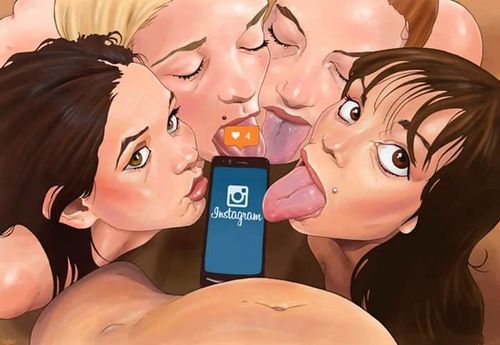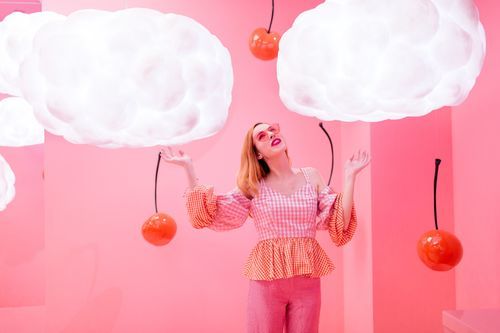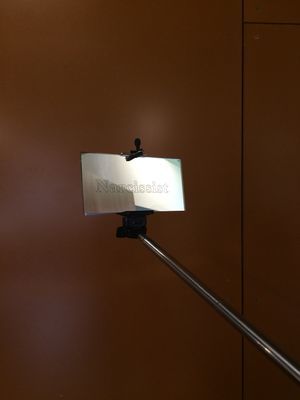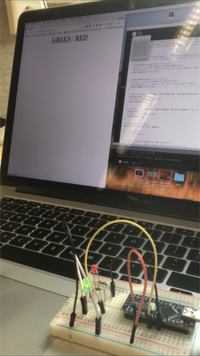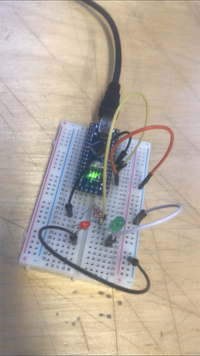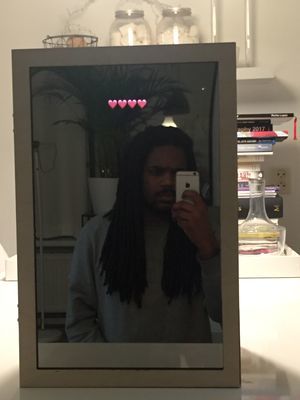User:Kenah/ResearchDocumentHTBH
Contents
Forward/Introduction
As a modern graphic designer, you design and create for communication purposes. But in the traditional sense, you do it for clients, either in the form of print or a screen. As a creative designer, I always wanted to dabble my feet in other media like photography, film and the physical world. At this point in time, I experience the traditional way of graphic design as very limiting. There are many senses the human species can use to get communicated to that don't get to be used if you just stick to print and/or screen, or complicated behaviors and situations that you can’t provoke or comment on. I work to discover and learn new ways of expressing and communicating my ideas and findings using other materials and mediums. In this way in the future, I have even more freedom to think outside the graphic design box. Though limiting, being a graphic designer does give me the advantage to already have a clear understanding of what to do in order to communicate ideas, principles, and feelings.
As a craftsman, I'm a conceptual creator. I find a story, a metaphor or a happening and create a project around it. We as humans are very complicated creatures. How we interact with each other, the physical world and with the digital realm, created a lot of opportunities to discover, highlight or enhance different corks and characteristics that we possess. Doing this, I hope to bring more awareness to how humans interact. This can be taken into consideration when developing new products or technologies. Or if newer technologies get produced, I can use them to let people reflect on the situation, either positive or negative, in order to create a better understanding of what really makes people tick in the progression and development that we experience.
Abstract
Now that internet is widely accessible, it has become an intricate part of our lives. It has streamlined our lives by making it easier to do all kinds of things. One of the interactions that I find most interesting is our social behavior. We are connected 24/7. That means we can also communicate and share our lives with the world posting anytime, anyplace using social media. These posts get a rating by the amount of likes you score or followers you acquire. This changes how we see, interact and behave around each other.
In this research project, I will research our relationship with social media (Instagram) and how it affects our behavior, lives and the interactions between each other and world around us. With the findings, I will conduct experiments to exploit or control these behaviors and try to bring awareness or a better understanding of what it can do to us.
Central Question
How does the use of Instagram influence views, values, and needs of users?
Relevance of the Topic
According to “Dreamgrow.com”, on September 2017 Instagram recorded a number of 800 million active users on their platform. It is the third biggest social media platform being used. People use it on a daily basis for personal and professional use. There are Instagram celebrities and influencers that have millions of followers. So the platform has become a world of its own. With its rating systems (followers & likes) and the used algorithms in play, the effects can have a big impact on the users and how they perceive their lives. There are a lot of studies and reports already written on mental health, addiction and other issues related to social media use in general and Instagram use in particular. Because of this, it is important to reflect on these behaviors and look at all angles of the interactions between the users and Instagram with a critical view
Hypothesis
The intention of my work is to make people question the platform and give them a better insight on how social platforms function. I want them to see beyond the pretty pictures, the followers count and the number of likes celebrities or friends get on their latest posts. I want people to question their own views and behavior and reflect on it. Thus creating a more aware and critical user that can decide where they place their value.
Research Approach
My research will consist of reading papers on mental health and addiction related to Instagram and other social media. I will also do artistic research to find related projects. But the biggest part of the research will consist of testing codes and prototyping experiments.
Key References
(how does your work relate to contemporary makers? what a key analogues/works of inspiration?)
Quiles, Luis. Revolutionary Road
SELFIE FACTORIES: THE RISE OF THE MADE-FOR-INSTAGRAM MUSEUM
Black Mirror: Nosedive. Dir. Joe Wright. creator Charlie Brooker ,2011
Stan Haanappel. SELFIE STICK
Literature
I found this book written by Henry Carroll Titled Read this if you want to be Instagram famous. the book is aimed at mainstream users that have the ambition to grow in the platform. It showcases a bunch of famous Instagramers. They tell a short story on what they do and how they became famous on Instagram. they also provide tips and statistics that give the readers more insight. But in my opinion, de book frames it all to be heavily glorified. It guides the reader through the fun part of Instagram but never mentions anything critical that comes with it.
In my opinion, Instagram represents a type of meritocratic society. In short, a meritocracy is a society where success is based on your talents, dedication and or hard work, basically your merits. But in social game experiments like Starpower: Experiencing a stratified society. It proves that only the lucky few get a pass and a chance to move up in the social later. in the case of Instagram, the ones that don't make it get a skewed sense of reality because they only see the beautiful curated side of the life of famous Instagrammers they wish for, resulting in mental health issues.
For example in an article I found about a research done on youth between 14 - 24, they found that Instagram is the most negative platform for mental health. It creates anxiety, can cause issues with sleep patterns, body image issues and cases of FOMO (Fear of missing out). these are al very serious subject that people don't really think about. But why do we keep coming back? Even the act of posting an image has an effect on our bodies. A video/article I found on business insider states that the reason it is so addicting is that every time you get a like dopamine gets released into your body.
these are all valid reason for me to want to investigate it and find my own answers to what I think about the platform. And hopefully, help others to be more critical about it.
Experiments
to experiment with Instagram I tested out different utilities. I started out how to get information from the users. I did this because it gave me data to work with. I could use the followers and following and have it be a part of my project. I also tested working With an Instagram API. I wanted to know and see what I could do with it. After that, I experimented with an open source Instagram bot because it helped me understand automation and how the bot generated likes and comments. Last I tried to work with an Instagram scraper.
I tried All these utilities get a better understanding of the inner workings of Instagram. Because of that, I found characteristics of the platform that could manipulate and use to create my projects.
I also experimented with the Raspberry Pi and Arduino. It allowed me to understand programming and circuitry to later make the experiments functional.
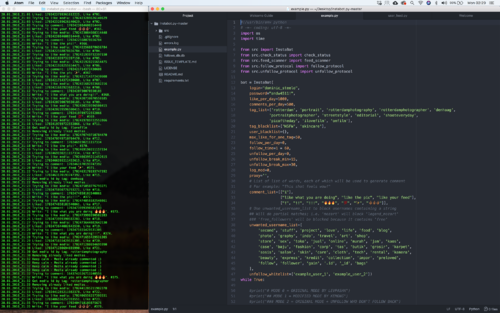 Instagram Bot
Instagram Bot
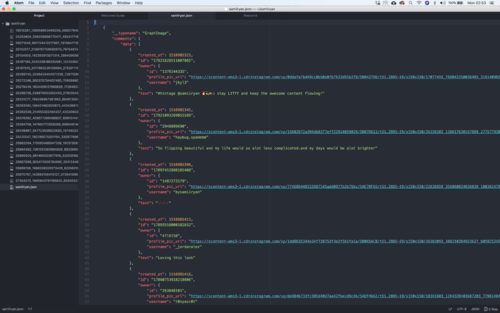 Instagram scraper
Instagram scraper
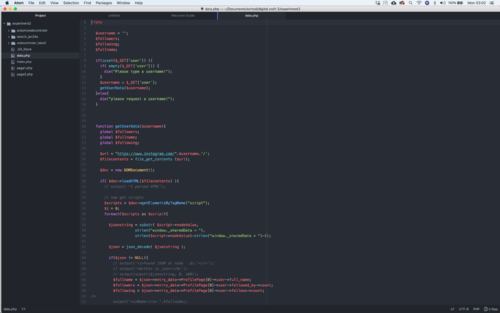 Data extraction
Data extraction
Insights from Experimentation
At the start of my process, I was endlessly brainstorming and sketching to find "The Idea". I was relying on assumptions and cheap visual symbolism to think of a reason to create my project. Social status, life philosophies like memento mori and meritocratic societies were subject where I tried to find clues to translate into something visual. It ended up being a convoluted story that didn't translate to the audience.
The project was a simple display case. Only the cover where you could look into the case, was a two-way acrylic mirror. This made it possible to keep the inside a secret to see what was inside. The visitor had to go to a website where they had to log in using their Instagram account information. This would then, based on their followers, send them either to a page where they would be notified that they were not allowed in or a game where they could turn on lights inside the display case.
The prototype that was supposed to become my main project ended up being my first experiment. When making it I learned a lot of new technical skills that helped me come up with better and clearer experiments. Building the website, an Instagram API and programming my Raspberry Pi, taught to work in the terminal of computers and code languages like PHP and Python. This made me research the working of bots available on the market. These bots enhance the engagement on your profile by automating liking and commenting on other profiles. It inspired me to modify and tweak the code and make new experiments that highlighted subject matters. The experiment also provided me with some material insight. Because there was no explanation next to my project on how to use it, visitors just stood there and tried to look at the inside but could only look at themselves. It made me realize that the design was faulty and that I would have to think of better options to bring my message across.
Artistic/Design Principles
My project will be made for the visitors having an experience. In order to make my projects work, I will have to make installations that create situations where visitors get drawn into interacting with it/them. The interactions must be straightforward so that visitors are attracted to use the installation and thereafter have a clear understanding of the intentions. The interaction will provoke thought.
Artistic/Design Proposal
I propose to make three experiments around features and extensions that come with Instagram. In this case I will be using data that users provide on Instagram and a bot that automates user engagements.
With the first experiment, the visitor will have to enter his/her username into the installation that guards an entrance. Based on the number of followers the user will be granted access to enter or not. This experiment comments on future situations where social segregation could be an issue.
In my second experiment the visitor will be given the opportunity to get new likes on a post. They will have to enter their username and then perform an action to get the likes. I hope this installation will put the people in a situation where they question if it is worth doing the action to get the likes (feed their addiction).
The third experiment will use a feature that bots use. I will use its automated comment feature to make a mirror for the narcissistic needs of the visitor. The mirror installation is meant to make the visitor reflect on the overly positive comments that are given by people and bots. Important questions for the visitor are: “Is it real?” “Is it a way to get more engagement?” “Do you need it for you narcissistic needs?”
Realised work
I used the liking functionality in the Instagram bot. I modified it so it would like a picture on a selected profile on a press of a button. The idea was that the visitor would have to insert there username to get likes. The button would be designed to make the visitor think twice before using it to get the likes. This could be a dildo or a shape that hints at one. To comment and provoke thought on what we are willing to do to feed the addiction of getting likes.
Another experiment I made is one that utilizes the information and data that your profile provides. The installation would provide access at an entrance by opening up or letting the visitor threw. They would have to give their username to see if they would have enough followers to get in. Hereby creating a situation where people can experience social segregation.
The last experiment I made is one that used the idea of a comment bot and the insight that people were looking at themselves in the reflection of the two-way mirror. The bot generates random sentence combinations based on input you give it and posts. By putting a screen with a black exterior behind a two-way mirror it would not interfere with the reflection of the visitor. On the screen, the user will see overly positive bots comments in white with a black background. The installation will be a mirror for narcissists.
Final Conclusions
I have to conclude that my project is not done yet. The second line of experiments are mostly all functional but have not yet been build into an installation. If or when I continue working on them I will design the experience and interaction threw exploration of materials and situations where or how it would make the most sense for the audience to get what the project is about.
But considering my reasoning behind every experiment I think I have clear enough concepts that will resonate with audiences. Think I successfully found solutions to awaken questions in the minds of the audiences regarding Instagram and if their values should be places on a social platform like that.
For myself experimenting and dissecting the ins and outs of Instagram has made me realize that for me at least getting all the attention on Instagram feels fake. I will be using the platform to place my work but I will abandon my value of being recognized there. I will use it more as a business tool to easily show people what I work on if they ask for it.
Bibliography
(what did you reference in this text (other texts, images, films, exhibitions)? Remember to use proper in-text citing!!!!!!!!!!
Carroll, Henry. Read this if you want to be Instagram famous. Laurence King Publishing, Ltd, 2017.
Mukhopadhyay, Carol C. STARPOWER: EXPERIENCING A STRATIFIED SOCIETY. 2014 http://www.sjsu.edu/people/carol.mukhopadhyay/race/Starpower-Activity-2014.pdf.
KALLAS, PRIIT. Top 15 Most Popular Social Networking Sites and Apps [January 2018]. NOVEMBER 7, 2017 · UPDATED JANUARY 16, 2018 https://www.dreamgrow.com/top-15-most-popular-social-networking-sites/
Business Insider Nederland . Dit gebeurt er met je hersenen als je een like krijgt op Instagram. 26 Mar 2017 https://www.businessinsider.nl/what-happens-to-your-brain-like-instagram-dopamine-2017-3/?international=true&r=US
Fox, kara. Instagram worst social media app for young people's mental health. May 19, 2017 https://edition.cnn.com/2017/05/19/health/instagram-worst-social-network-app-young-people-mental-health/index.html
Pardes, Arielle. SELFIE FACTORIES: THE RISE OF THE MADE-FOR-INSTAGRAM MUSEUM. 27.09.2017 https://www.wired.com/story/selfie-factories-instagram-museum/
Black Mirror: Nosedive. Dir. Joe Wright. creator Charlie Brooker ,2011
Quiles, Luis. Revolutionary Road https://www.facebook.com/luisquilesart/
